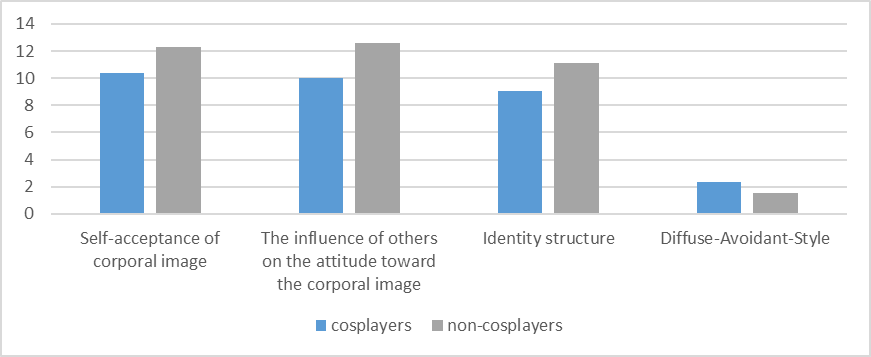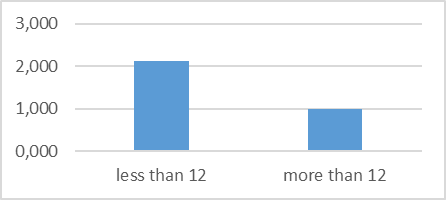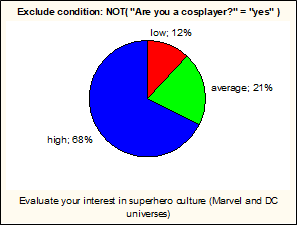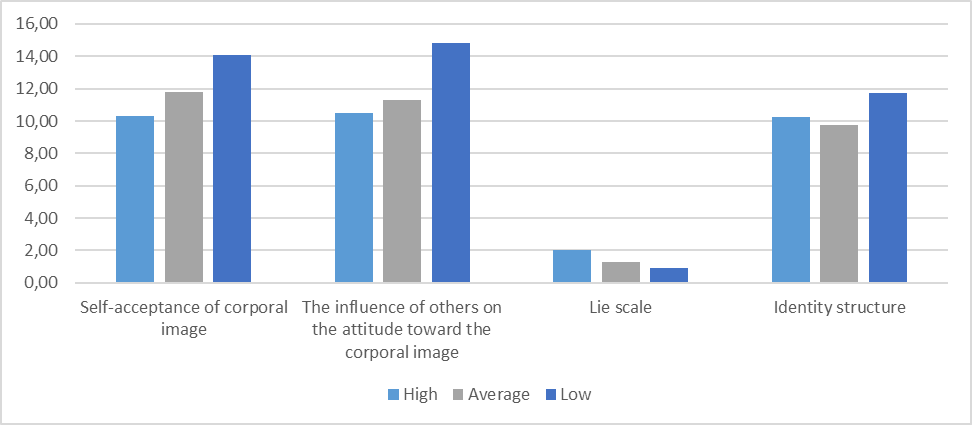Abstract
The difficulties of self-identification in the modern transitive world are discussed. The importance of popular culture for the modern young generation is considered. Popular subcultures such as cosplay and superheroics are being analyzed. Assumptions are made about the meaning of identification with various characters of pop-culture (geek culture) for the process of formation and awareness of identity. Modern world cinema is seen as a source of influence on the audience through the use of a variety of attractive characters with which viewers can identify themselves and experience their own life dilemmas through on-screen stories. Discusses the reasons for the attractiveness of superheroes as the most popular characters of modern world cinema. The characteristics of the perception of superheroes by the modern viewer and the preferences of their significant characteristics are analyzed. The results of the study of representatives of the cosplay subculture and people with different levels of involvement in the culture of superheroes are given. The differences between cosplayers and non-cosplayers, as well as people with different levels of involvement in superheroics, are analyzed in terms of body image, identity styles and the functions of identity. The conclusion about the connection of the features of identity and self-acceptance to the level of involvement in modern subcultures is made. Outlined prospects for further research of the claimed phenomenon in terms of mechanisms and meanings.
Keywords: Identitypopular culturecinemasuperherocosplay
Introduction
In the situation of social transitivity, defined as the variability, uncertainty and multiplicity of macro and micro social spaces (Martsinkovskaya, 2015a), the role of subculture as an environment for socialization and individualization of young people significantly increased.
Modern subcultures help people self-categorize and define self-identification in the conditions of social transformations. Today's mass culture provides many samples for identification to the young generation. And one of the most significant cultural spaces in which the socialization of modern man takes place is world cinema. Besides the fact that it still attracts millions of viewers of all ages, today any movie or series can be downloaded on the Internet. Thanks to this, viewers can find and select exactly the content that meets their needs. Cinema as one of the main sources of information impact contributes to the formation of worldview, values and behaviors. Watching a movie is also a specific coping strategy that plays a special role in a situation of transitivity. Social transitivity in itself can be viewed as a complex situation that reduces a person’s socialization potential in a changing and uncertain world (Martsinkovskaya & Yurchenko, 2016). Through identification with the heroes and living on-screen history, viewers metaphorically overcome their own difficulties and completes their identity. Through experiencing and understanding emotions, finding new resources and overcoming difficulties develops awareness and improves competence in life (Orestova, 2017). Watching the film creates role-experimenting conditions for the viewer. Identification with the hero gives the opportunity to try on the characteristics of another person, to see, feel and live what does not exist in real life and get incredible features and superpowers.
Analysis of modern world cinema shows that the most important content for understanding the modern youth are films about superheroes. Today films based on comics about people with superpowers are one of the most widespread areas of popular culture. In addition to visiting cinemas and watching cinema-related content on-line, a huge audience and budgets are involved in such by-products as Comic con (festival of comics and related art), various merchandise (products with a certain symbolism) based on comics. Another popular direction of pop culture is cosplay, a subculture built on recreating and acting out a chosen image from any popular media source - video games, comics, film, series, cartoon, artwork. Cosplayers, trying on various images, get the opportunity for role-based experimentation that helps them to build their own identity.
An important aspect of self-identification is somatic identity. Through identification and contrasting of the real physical appearance with the ideal image of the character, identity is built and realized. At the same time, the canonical images of superheroes are most often the embodiment of extremely exaggerated gender and sex stereotypes, in which the parameters of the male and female body are the caricatures of a sexual dimorphism (Johnson, Lurey, & Freeman, 2008). Based on this fact, we can expect negative effects for the formation of a body self due to identification with a physically perfect superhero. However, studies show that is not so simple (Young, Gabriel, & Hollar, 2013). Under certain conditions, comparing a real body and assimilating with a superhero image promotes self-acceptance.
Thus, incredible attractiveness of the culture of superheroes has several reasons. External factors - the attractiveness of the characters, special effects, widespread advertising and active promotion of films. They play a big role but are not the only reasons for such popularity. Stories about superheroes are a kind of mythology of our time - like the myths of ancient Greece, adapted to modern times (Rosenberg, 2013). In high-tech blockbusters, we see archetypical stories about the hero's path. Simple and predictable scenes allow the viewer not only to escape into an alternate reality, but also face various eternal human dilemmas. And the key to solving these dilemmas are not superpowers, but simple human qualities.
The results of our research about the image of a modern superhero suggest that viewers associate the archetypical image of the hero not only with the presence of superpowers. It seems that simple human qualities, such as visual appeal, emotional sensitivity and a good sense of humor attract viewers. Based on this, identification with understandable superheroes and their nonsuperhuman qualities is more effective way to successful socialization in the modern transitive world (Orestova & Tkachenko, 2018).
Problem Statement
The situation of social transitivity gives rise to the difficulties of self-determination and the maintenance of integrity. In the middle of the last century, E. Erickson wrote that while solving the problem of building an identity, in order to protect themselves from disintegration, young people can over-identify with the heroes of books and companies (Erickson, 1968). In fact, today such a role is played by various subcultures, and now the subculture defines not only the micro-social environment, but, taking into account the involvement of young people in various social networks, it goes beyond its limits, transforming into the macro-social context of socialization. Categorization of subcultures helps self-categorization. Identifying with the subculture, a person begins to better understand and accept himself, aware of and partly forms identity. The world of superheroes is one of such cultures favorable for self-testimony, providing a variety of role models that have both vivid external characteristics and personal features, clearly defined values, and they are universal, understood by everyone, regardless of age, place of residence, ethnicity. As already mentioned, the world of superheroes is not limited to cinema, and we can distinguish different levels of people's involvement in this culture. So, there are those who watch and review all the films about superheroes that appear on the screen, or watch them from time to time, there are people who buy various superhero symbols, cosplayers, etc.
It is obvious that people with different levels of involvement in the world of superheroes realize different needs through it. It can be assumed that a high level of involvement suggests the need to identify with such a massive, bright and attractive subculture to build their own identity. It is interesting to explore the choice of favorite characters, the process of identification with the character and the determination of the value of certain qualities.
Research Questions
We assume that respondents with a high level of involvement in the subculture of cosplay and in the culture of superheroes would have significantly expressed indicators of the diffuse identity style. At the same time, their indicators of self-acceptance of corporal image, harmony and commitment will be significantly lower than among those representatives who less involved in these subcultures.
Purpose of the Study
The hypothesis was tested in a pilot study of the structure of the identity of the respondents with varying degrees of involvement in the most popular among novaday young people cosplay and superheroes subcultures.
Research Methods
Participants
In 2019, we conducted an online survey among 86 Internet users between the ages of 17 and 40 years old (60 women and 26 men). 34 respondents attributed themselves to the subculture of cosplayers, the other 52 were classified as non-cosplayers. All the respondents gave their consent to participate in the study.
Methods
The following diagnostic methods were used to identify relevant indicators:
"The diagnosis of the body image" by Lybko (2008).
Identity Style Inventory by M. Berzonsky (as cited in Belinskaya & Bronin, 2014).
The Functions of Identity Scale (Martsinkovskaya, 2015b).
Also, our respondents rated their interest in superheroic culture (their interest in the characters represented in the comic books and movies of Marvell and DC) on a scale from 0 to 5. As a result, they were assigned to three levels of involvement: low (0-1 points), average (2-3 points) and high (4-5 points).
Findings
To test our assumptions, we separately considered the indicators of bodily image, identity styles and identity functions in cosplayers and non-cosplayers groups and groups ща respondents with different levels of involvement in superhero culture.
Cosplayers V.S non-cosplayers
In the beginning, we compared the indicators of the identity of cosplayers and non-cosplayers in using the Mann-Whitney U test. The results are presented in figure

To test this assumption, we compared the characteristics of the identity of cosplayers according to different criteria: how many years have been engaged in cosplay and how many costumes have been in the collection (figure

Using Spearman’s rank correlation coefficient to analyze cosplayer group data, we found that the high indicators of the Lie scale are associated with high indicators of the Informational Style. While high values of Diffuse-Avoidant-Style are associated with low indicators of Harmonious and Future (table
As we see, cosplayers with developed self-reflexivity and the need to acquire new knowledge about themselves are characterized by insincerity in evaluating the acceptance of their physical self. It is interesting because cosplay literally allows them to try on different variants of identity and physical appearances. While engaging in cosplay, a person is quite rational in determining what suits him and what does not. And this is quite clearly revealed while wearing a suit and trying to conform to a particular image. Thus, if we associate these results with the results of comparing cosplayer with a different number of costumes, it can be assumed that at some point the number of satisfying images becomes sufficient to self-accept (including physical-self) and let them honestly evaluate the acceptance of the body and influence of others on it`s image. But whether cosplay allows them to accept the true self or to create an acceptable self? And the most important question - what is “true self” for cosplayers?
We also see that the cosplayers' tendency to avoid dealing with identity conflicts and decisions is associated with low harmony between values, beliefs, and commitments and weak ability to recognize potential in the form of future possibilities and alternative choices. It seems that participation in cosplay allows them to overcome these problems by giving the opportunity to cope with the unformed identity and weak value structure using ready-made holistic models (belonging to preferred characters) that have already been accepted by society and have shown their effectiveness in certain situations.
Involvement in superhero culture
In order to clarify the connection between the integrity of identity,self-acceptance, and involvement in popular subcultures which give an opportunity to identify with ammount of different powerful and attractive characters, we checked whether cosplay is connected with superhero culture. Using the chi-square test, we estimated the distribution of respondents with different levels of involvement in superhero culture among those who identified themselves as a cosplayer or non-cosplayer.


As we see, among the respondents from the cosplayers group, the majority (68%) demonstrates a high level of involvement in the superhero subculture (figure
The comparison of respondents with different levels of involvement in the subculture of superheroes (figure 5) shows that ones with low levels of involvement demonstrate high values of Self-acceptance of corporal image (p=0,001 and 0,023), The influence of others on the attitude toward the corporal image (p=0,000 and 0,002) and Identity structure (p=0,044). We also found that respondents with high level of involvement in a superhero culture show higher Lie scale values than respondents with average (p=0,009) and low (p=0,004) levels of involvement.
These results complement previous ones obtained on a group of cosplayers. We see that superhero culture, which is so popular all over the world among people of different ages, truly reflects the peculiarities of the identity of its followers. In many ways, the subculture of superheroes, as well as cosplay, attracts mainly people with a low level of self-acceptance and diffuse identity. Apparently, a subculture that provides a wide selection of holistic images of characters with incredible physical qualities and exciting stories allows people to choose the most appropriate models to build their own identity.
Conclusion
The results of your research suggest that there is a significant connection between the characteristics of the identity of modern youth and the level of their involvement in popular subcultures. High rates of diffusion in self-identification, non-acceptance and insincerity in the perception of the physical self are more pronounced among the followers of the popular trends of modern culture. Obviously, for them cosplay and superhero care the significant sources of attractive and diverse models based on which they can complete or build their own identity. However, our study doesn't reveal any mechanisms or substantive aspects of this phenomenon, but only outlines a tendency to further investigation of the connection between modern trends in pop-culture and the identity features of its followers.
Acknowledgments
The work is support by grant RSF 19-18-00516 “Transitive and virtual spaces: common and different features”.
References
- Belinskaya, E.P., & Bronin, I.D. (2014). Adaptation of the Russian version of the identity styles questionnaire by M. Berzonsky. Psikhologicheskie Issledovaniya, 7(34), 12. Retrieved from URL: http://psystudy.ru/index.php/num/2014v7n34/964-belinskaya34.html
- Erickson, E. H. (1968). Identity: Youth and Crisis. New York. London: W. W. Norton & Company.
- Johnson, K. L., Lurey, L. E., & Freeman, J. B. (2008). Gender Typicality and Extremity in Popular Culture. In R.S. Rosenberg (Ed.), Psychology of Superheroes: An Unauthorized Exploration (pp. 229-245). Dallas, TX, USA: BenBella Books.
- Lybko, I.V. (2008). The method of body image diagnosing. Psikhologicheskaya diagnostika [Psychological diagnostics], 3, 5 - 21.
- Martsinkovskaya, T.D. (2015a). Modern psychology - challenges of transitivity. Psikhologicheskie Issledovaniya, 8(42), 1. Retrieved from URL: http://psystudy.ru/index.php/num/2015v8n42/1168- martsinkovskaya42.html
- Martsinkovskaya, T.D. (Ed.) (2015b). Identity and socialization in the modern world. Moscow: MPGU Press.
- Martsinkovskaya, T.D., & Yurchenko, N.I. (2016). Coping strategies in transitive society. Psikhologicheskie Issledovaniya, 9(49), 9. Retrieved from URL: http://psystudy.ru/index.php/num/2016v9n49/1332-martsinkovskaya49.htm
- Orestova, V.R. (2017). Cinema and psychology of everyday life. Psikhologicheskie Issledovaniya, 10(56), 5. Retrieved from URL: http://psystudy.ru/index.php/num/2017v10n56/1498-orestova56.html
- Orestova, V.R., & Tkachenko, D. P. (2018). The reflection of the needs of today's young people through the film preferences and perceptions of superheroes in the conditions of transitivity. Psikhologicheskie Issledovaniya, 11(61), 11. Retrieved from URL: http://psystudy.ru/index.php/num/2018v11n61/1629-orestova61.html
- Rosenberg, R.S. (2013). Our Superheroes, Ourselves. Oxford: Oxford University Press.
- Young, A. F., Gabriel, S., & Hollar, J. L. (2013). Batman to the rescue! The protective effects of parasocial relationships with muscular superheroes on men's body image. Journal of Experimental Social Psychology, 49(1), 173-177.
Copyright information

This work is licensed under a Creative Commons Attribution-NonCommercial-NoDerivatives 4.0 International License.
About this article
Publication Date
14 July 2019
Article Doi
eBook ISBN
978-1-80296-063-1
Publisher
Future Academy
Volume
64
Print ISBN (optional)
-
Edition Number
1st Edition
Pages
1-829
Subjects
Psychology, educational psychology, counseling psychology
Cite this article as:
Orestova*, V. R., Tkachenko, D. P., & Karpuk, V. A. (2019). Identity Of Modern Youth Through The Prism Of Mass Culture. In T. Martsinkovskaya, & V. R. Orestova (Eds.), Psychology of Subculture: Phenomenology and Contemporary Tendencies of Development, vol 64. European Proceedings of Social and Behavioural Sciences (pp. 475-483). Future Academy. https://doi.org/10.15405/epsbs.2019.07.62
